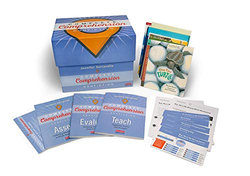- 28 high-quality trade titles
- a unique whole-book assessment
- evaluation rubrics
- 100+ reading strategies to share with readers
- Determining the main idea of of sections, chapters, and the whole book
- Identifying and separating key details from extraneous information, and understand the relationship between facts
- Figuring out the meaning of content-specific, technical vocabulary by using the text and features
- Using text features to support and deepen understanding.
- assess a student's whole-book comprehension via each of the four goals
- evaluate their facility with the component skills of each goal to plan instruction
- teach reading strategies directly matched to the needs you identify.
Assess
Complete Comprehension includes 28 authentic trade books (two each at levels J to W) by award-winning and beloved authors on topics of interest to young readers. A student chooses from among the texts, then reads independently. As they read, labels affixed in the book cue them to pause their reading and write their answer in response to open-ended prompts on a provided response form. No instructional time is required to obtain these written assessments: Students read and answer prompts on their own while teachers can continue working with other students who are not engaged in the assessment. The Assess guide includes instructions on how to introduce the assessment to the whole class, how to gather and prepare your resources, how to administer the assessment with individual students, how to support book selection, and how and when to assess students. All of the prompts for all 28 books are also included for easy reference.
Evaluate
Once you've received a student's response form, Jen's commonsense rubrics in the Evaluate guide help you make sense of the responses and pinpoint opportunities for growth. Spend a short amount of time with these rubrics and your student's response form in hand, typically 10 to 15 minutes when you first start getting to know the rubrics, and as little as 5 minutes with increased proficiency. Sample student responses from Jen's own field research, keyed to the progressions she shared in Understanding Texts & Readers, help you determine whether a reader is approximating a skill, is proficient with it, or demonstrates exceptional understanding. Once you've evaluated each response on the form, use the Planning Form, a quick tally sheet, and the if-then table that recommends clear next steps pinpointed to the reader's strengths and needs. The Evaluate guide includes a 4-step protocol for evaluation, suggestions for getting the most out of the rubrics, summaries of each included trade book, guidance on what to look for in students' responses, and sample student responses.
Teach
Teachers love The Reading Strategies Book, and Complete Comprehension provides 100+ strategies in the Teach guide: 75+ strategies unique to Complete Comprehension and 20+ variations on some of the most foundational strategies from The Reading Strategies Book. Each strategy is on its own page, and formatted just like those in in The Reading Strategies Book, with classroom charts, lesson language, and mentor text suggestions. Organised with a chapter for each of Jen's four comprehension goals for nonfiction and one for reader engagement, the Teach guide makes selecting the most beneficial strategy for a student easy.




Share This Book: